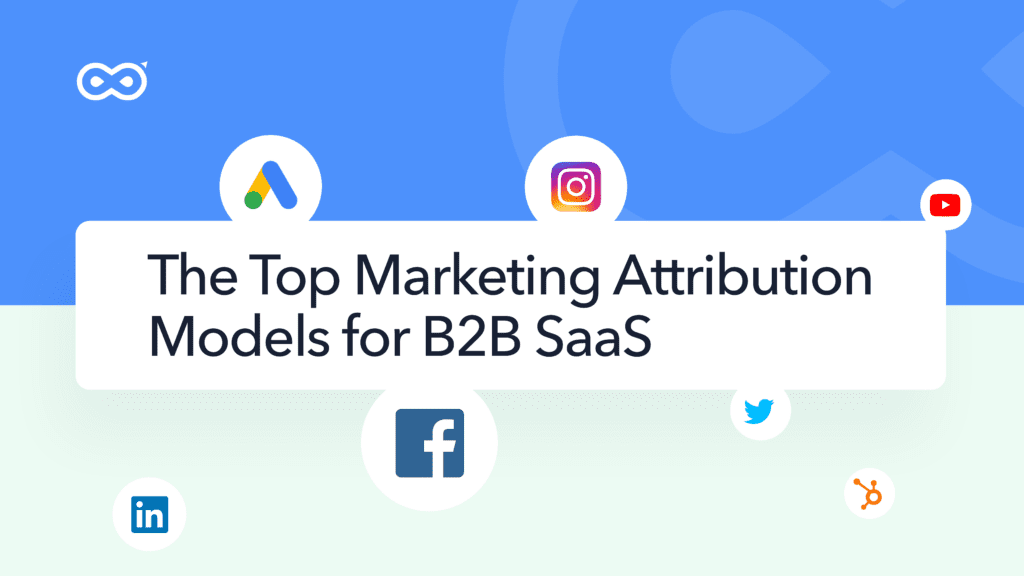Marketing attribution software has become part of the core marketing technologies used by B2B SaaS companies.
There is good reason for this! SaaS companies tend to invest a lot in marketing, and well…you want to understand what you are getting in return.
As a marketing leader, you need to fully understand the impact of your marketing channels on the bottom line results of the business and this is becoming a lot more difficult to do in the modern B2B marketing environment.
With so many marketing channels available (and additional ones being created all the time), customer journeys are becoming increasingly more complex. Many touchpoints, both online and offline, work in conjunction with one another and contribute to revenue. In addition, B2B marketers are often dealing with multiple personas and multiple contacts within a single company. This adds an additional layer of complexity in analyzing and understanding the impact of marketing channels on the customer journey.
Despite its clear value, Marketing Attribution is a complicated concept. Many different attribution models exist and there are a lot of questions marks about which is the best model to use in B2B SaaS and what is the best way to measure the effectiveness of marketing.
In this post, we will cover the different Marketing attribution categories and models used by B2B Marketers and provide insights into what you should consider when evaluating marketing attribution models for your company.
Let’s first start with a simple example that we can use to show how each attribution model attributes the revenue generated from this specific customer and his journey.
The Journey
John is the VP of Marketing at a B2B SaaS company and he is looking for a solution to help him build, track and optimize his marketing budget. Guess what? You are working for a company that has a product to do just that!
John’s journey was as follows:
- He first was exposed to your brand by when he met your team at a conference that your were sponsoring (EVENTS)
- Later, when searching on Google for “B2B SaaS marketing planning”, he came to your website by clicking on a blog post and eventually signed up for your newsletter. (SEO)
- After one particularly interesting newsletter, John clicked on a CTA in the email and signed up for a free trial of your product. (EMAIL)
- When John saw a relevant post on Twitter, he clicked on the link to read the article. (TWITTER – ORGANIC)
- Finally, after clicking on a retargeting ad on LinkedIn to attend a webinar, sales took over John’s account and converted him into a paying customer. (LINKEDIN – PAID)
John and his company purchased an annual license for $50K and you got new ARR of $50K 😎
Now that we have a simple example of a customer journey, it’s time to get back to the discussion of marketing attribution models and how they would attribute the $50K ARR from this example.
Single-Touch Marketing Attribution
Single-Touch Attribution was the earliest incarnation of marketing attribution. With single-touch attribution models, the revenue value is credited to one single touchpoint in the customer journey.
It is clear to see why single-touch attribution is a problematic attribution category for B2B marketers. B2B marketing today is filled with a wide variety of touchpoints. By taking the narrow approach of single-touch attribution, you ignore the impact of other marketing channels and touchpoints in the buyer journey in favor of one, single touchpoint. While certain touchpoints may be more significant than others, it almost seems flawed to ignore the other touchpoints in a customer journey. Often in B2B, you have longer sales cycles and a lot more than just one single touchpoint before the money comes in, so multi-touch attribution is critical to accurately evaluate your marketing channels.
There are 2 main marketing attribution models that fall under the single-touch attribution category: Introducer and Converter.
Introducer Attribution Model
Commonly known as “first-touch attribution”, the Introducer attribution model is based on the view that that the channel that initially introduced the customer to your brand/product is what ultimately was responsible for the conversion. Thus, the Introducer model assigns full credit for the conversion to the first touchpoint in the customer journey.
How does it work?
Based on our example of John and his journey, when using the introducer model, Events would get the full credit as it was the first touchpoint for John. $50K ARR would be attributed to Events.
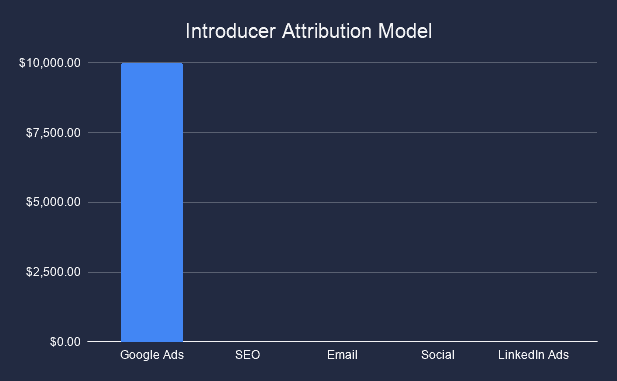
Attributed Revenue:
- Events: $50K
- SEO: $0
- Email: $0
- Twitter – Organic: $0
- LinkedIn – Paid: $0
Converter Attribution Model
The Converter attribution model, also known as “last-touch attribution”, also takes a basic approach to attributing the revenue. This model assumes the opposite of the Introducer model. It is based on the view that the last touchpoint in the customer journey, the one that occurred immediately before the conversion, was what ultimately drove the conversion and therefore it assigns full credit for the conversion to that last touchpoint.
How does it work?
Using the example of John and the Converter attribution model, the $50K ARR would be entirely credited to LinkedIn – Paid as it was the last touchpoint in his journey.
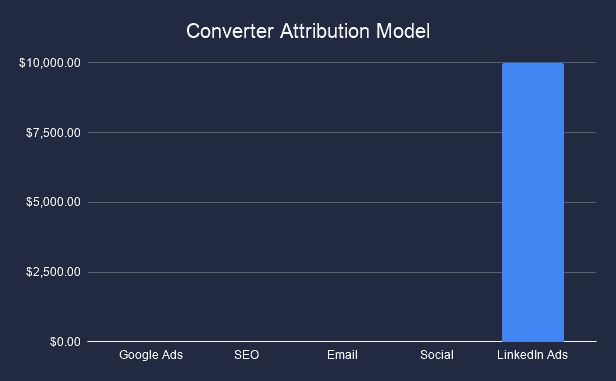
Attributed Revenue:
- Events: $0
- SEO: $0
- Email: $0
- Twitter – Organic: $0
- LinkedIn – Paid: $50K
Multi-Touch Marketing Attribution
Multi-touch attribution is the latest category of marketing attribution and is much more of a realistic approach for modern B2B marketers. The basic premise of multi-touch attribution is that all touchpoints in a customer’s journey have an impact on conversion, the only question is how much of an impact do they have. The various attribution models that exist under the multi-touch attribution category each have their own answers to that fundamental question.
B2B marketers prefer multi-touch attribution because of the complexity of modern customer journeys and the usage of a wide variety of online and offline channels to drive conversions. Logically, it also makes the most sense…that all touchpoints contribute, in one way or another, to a conversion.
Multi-touch marketing attribution is also becoming a significant investment for B2B marketers. In 2018, marketers spent $816M on multi-touch marketing attribution solutions and that spend is expected to hit $1.6B by 2023.
Multi-touch attribution models can be divided into two categories:
- “Rule of Thumb” Models
- Data-Driven Models
“Rule of Thumb” models each follow general credit attribution rules (a specific % of attributed credit for certain touchpoints). Multi-touch marketing attribution models that fall into this category are Linear, Time Decay, U-Shaped, W-Shaped and Full Path (Z-Shaped) models.
Data-driven models apply machine learning to collect data from the customer journey and are dynamic in the way their attribute credit to the marketing channels in the journey.
Linear Attribution Model
The Linear attribution model is all about equality. Based on the premise that every touchpoint equally impacted the conversion, the Linear attribution model assigns equal credit to every touchpoint along the customer journey.
How does it work?
The Linear attribution model would credit each channel evenly (in this case, $10K each) for the $50K in ARR that John brought.
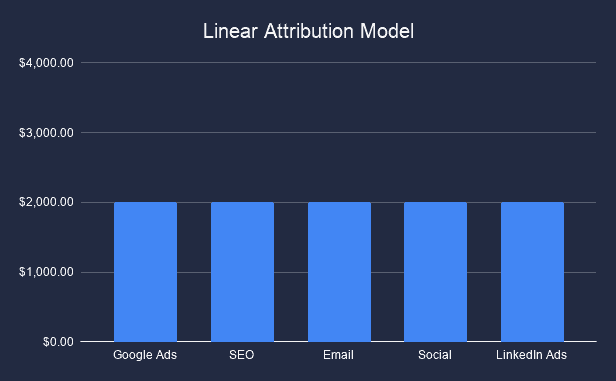
Attributed Revenue:
- Events: $10K
- SEO: $10K
- Email: $10K
- Twitter – Organic: $10K
- LinkedIn – Paid: $10K
Time Decay Attribution Model
The time decay attribution model is a more advanced attribution model that is based on the assumption that the more recent touchpoints in a customer’s journey had a much greater impact on the conversion than touchpoints that occurred in the past.
How does it work?
Using John’s journey, the time decay model would credit each touchpoint in the journey, just on a reduction basis – each touchpoint that occurred farther from the point of conversion would receive less credit. In our example, LinkedIn – Paid would get the bulk of the credit because it was the the most recent touchpoint prior to conversion.
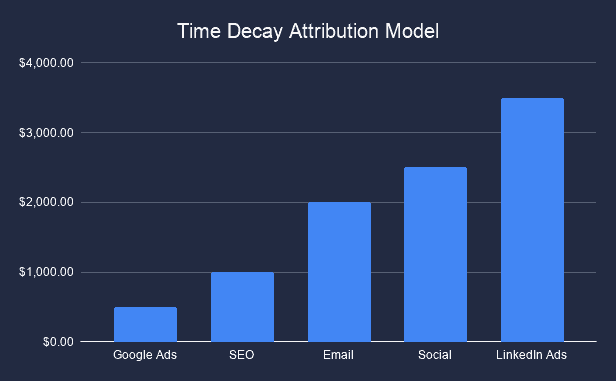
Attributed Revenue:
- Events: $1K
- SEO: $3K
- Email: $26K
- Twitter – Organic: $2.5K
- LinkedIn – Paid: $3.5K
U-Shaped Attribution Model
The U-Shaped marketing attribution model is based on the view that the first and last touchpoints (in some cases, first and lead creation touchpoints) are the most impactful on the conversion and are therefore assigned greater credit that the touchpoints that occurred between these events.
How does it work?
The U-Shaped attribution model has a pretty specific credit assignment formula: 40% is credited to the first touchpoint and last touchpoint on the customer journey, with the remaining 20% evenly credited among the other touchpoints. In John’s case, Events and LinkedIn – Paid would receive 80% of the revenue credit with the remaining 20% evenly distributed among the other touchpoints.
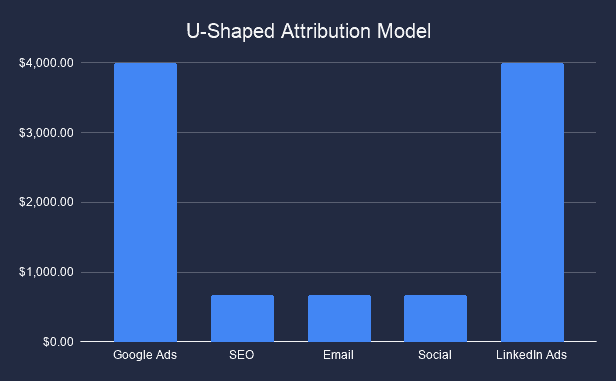
Attributed Revenue:
- Events: $20K
- SEO: $3.33K
- Email: $3.33K
- Twitter – Organic: $3.33K
- LinkedIn – Paid: $20K
W-Shaped Attribution Model
The W-Shaped attribution model is based on the view that the touchpoint leading to the actual creation of the lead is as significant as the first touchpoint and the last touchpoint prior to conversion.
How does it work?
Similar to the U-Shaped attribution model, the W-Shaped attribution model has a set credit assignment formula: the first touchpoint, the touchpoint that led to the actual creation of the lead and the last touchpoint before conversion each receive 30% of the revenue credit, while the other touchpoints get the remainder.
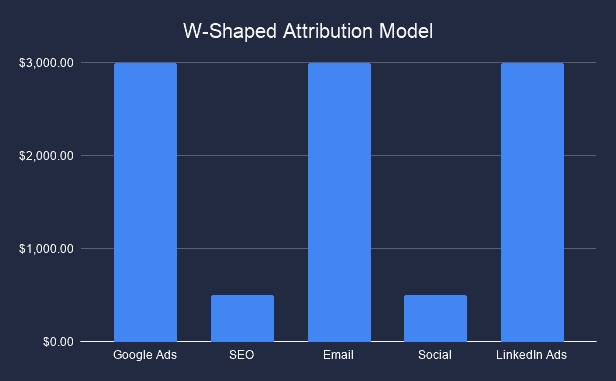
Attributed Revenue:
Events: $15K
SEO: $2.5K
Email: $15K
Twitter – Organic: $2.5K
LinkedIn – Paid: $15K
Full Path (Z-Shaped) Attribution Model
The Full Path (Z-Shaped) attribution model is the most comprehensive of the attribution models.
How does it work?
The Full Path (Z-Shaped Attribution Model) also has a set credit assignment formula that it uses to determine the revenue attributed to each channel. It prioritizes 4 primary touchpoints: First Touch, Lead Creation, Opportunity Creation and Last Touch. These events are assigned 22.5% of the credit (90% total), with the remaining 10% spread out over the remaining channels.

Attributed Revenue:
- Events: $11.25K
- SEO: $11.25K
- Email: $11.25K
- Twitter – Organic: $5K
- LinkedIn – Paid: $11.25K
Data-Driven Marketing Attribution
The data-driven (or custom) marketing attribution models apply machine learning algorithms to the data collected from the customer’s journey to identify and properly credit the marketing channels that played a significant role in the conversion of the customer.
Unlike the “rule of thumb” models, it does not have a set formula for how much credit to assign to each major touchpoint. Instead, the credit attributed to the channels in a customer’s journey is dynamic and changes when the data shows
Which marketing attribution model is right for my marketing organization?
Unfortunately, there is no magic answer to this question.
B2B SaaS is so diverse that you’ll be hard-pressed to find a “one-size fits all” marketing attribution model.
In some cases, you might need to employ multiple attribution models within the same business. For example, the marketing that you do for your self-serve SaaS product will greatly differ from the marketing that you do for your enterprise offering, potentially requiring different attribution models within your segments.
But there are things that you can ask yourself when reviewing attribution models.
- Does this marketing attribution model actually make sense for our business (sales cycle length, business model, decision-making hierarchy, etc.)?
- Is it flexible? Can it adapt over time to meet the growing and changing nature of our business?
- Do I trust it? Do I actually believe in the accuracy of the credited revenue associated with my marketing channels?
That being said, we do have an opinion…
Multi-touch attribution is the right category of marketing attribution for B2B SaaS. Due to the highly dynamic nature of B2B SaaS marketing, choosing a data-driven model, powered by machine learning,
Multi-touch attribution credits all touchpoints in the journey because every touchpoint DOES contribute toward conversion and revenue. It provides the greatest clarity into the impact of your marketing channels and their ability to generate revenue for your business.
This information can provide insights that can be used to allocate budget towards the most effective channels to hit your goals and to build better marketing plans for your organization.
Attribution is not everything you need in order to effectively optimize your marketing budget, but it’s a critical component in the process.

